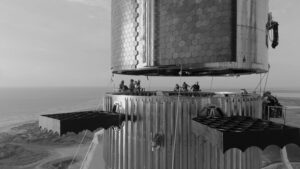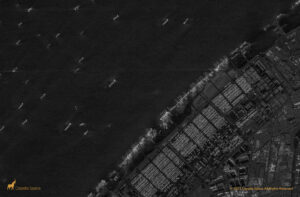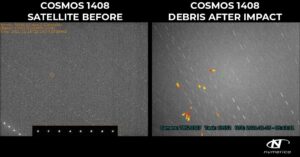Arianespace to launch Australian satellite Optus-11 with Ariane 6
Thursday, 18 November 2021 07:30 Arianespace and Australian operator SingTel Optus signed the launch contract for the Optus-11 communications satellite. The launch, scheduled for the second half of 2023, will use the Ariane 64 version of the Ariane 6 launcher, with four solid boosters.
Optus-11 is a Ku-band communications satellite with a coverage zone encompassing Australia and New Zealand. Optus-11 incorporates a number
Arianespace and Australian operator SingTel Optus signed the launch contract for the Optus-11 communications satellite. The launch, scheduled for the second half of 2023, will use the Ariane 64 version of the Ariane 6 launcher, with four solid boosters.
Optus-11 is a Ku-band communications satellite with a coverage zone encompassing Australia and New Zealand. Optus-11 incorporates a number Pangea Aerospace hot fire tests the first MethaLox aerospike engine in the world
Thursday, 18 November 2021 07:30 Pangea Aerospace, a company from Barcelona (Spain), has fired several times the first MethaLox aerospike engine in the world in their first try, at DLR Lampoldshausen facilities. The company has reached a major milestone for rocket propulsion, after the success of the hot fire test campaign of its aerospike engine. Pangea Aerosapce has ignited and hot fired several times a 20kN regeneratively co
Pangea Aerospace, a company from Barcelona (Spain), has fired several times the first MethaLox aerospike engine in the world in their first try, at DLR Lampoldshausen facilities. The company has reached a major milestone for rocket propulsion, after the success of the hot fire test campaign of its aerospike engine. Pangea Aerosapce has ignited and hot fired several times a 20kN regeneratively co Musk says first orbital flight for Moon rocket in early 2022
Thursday, 18 November 2021 07:30 Elon Musk said Wednesday that the Starship developed by his company SpaceX and selected by NASA for the Americans' return to the Moon would attempt its first orbital flight early next year.
"We'll do a bunch of tests in December and hopefully launch in January," Musk said in a talk for the National Academies Space Studies Board.
"There's a lot of risk associated with this first launch,"
Elon Musk said Wednesday that the Starship developed by his company SpaceX and selected by NASA for the Americans' return to the Moon would attempt its first orbital flight early next year.
"We'll do a bunch of tests in December and hopefully launch in January," Musk said in a talk for the National Academies Space Studies Board.
"There's a lot of risk associated with this first launch," Russia ready to discuss all space security issues with US
Thursday, 18 November 2021 07:30 Russia is ready to discuss the entire spectrum of space security issues with all interested countries, including the United States, Russian Foreign Ministry spokeswoman Maria Zakharova said.
"We confirm our readiness to discuss the entire spectrum of space security issues with all interested states, including the United States. We are convinced that the launch of negotiations on an interna
Russia is ready to discuss the entire spectrum of space security issues with all interested countries, including the United States, Russian Foreign Ministry spokeswoman Maria Zakharova said.
"We confirm our readiness to discuss the entire spectrum of space security issues with all interested states, including the United States. We are convinced that the launch of negotiations on an interna Russian MoD: US Perfectly Aware Fragments of Downed Satellite Pose No Threat to Space Activities
Thursday, 18 November 2021 07:30 On Monday, State Department spokesman Ned Price accused Russia of "recklessly" carrying out a destructive satellite test using an anti-satellite missile against a defunct Soviet satellite. Washington claims the test generated "over 1,500 pieces of trackable orbital debris" which now "threaten the interests of all nations."
The Russian military confirmed Tuesday that it has carried out a su
On Monday, State Department spokesman Ned Price accused Russia of "recklessly" carrying out a destructive satellite test using an anti-satellite missile against a defunct Soviet satellite. Washington claims the test generated "over 1,500 pieces of trackable orbital debris" which now "threaten the interests of all nations."
The Russian military confirmed Tuesday that it has carried out a su Russian Military Publishes First Video From Successful Anti-Satellite Missile Test
Thursday, 18 November 2021 07:30 Earlier in the day, the Defence Ministry confirmed that Russia had successfully conducted an anti-satellite test on Monday, hitting a long-defunct Soviet satellite floating lifelessly in orbit. The military dismissed claims made by US officials that the test creates thousands of pieces of debris "threatening the interests of all nations."
The Russian Ministry of Defence published a video T
Earlier in the day, the Defence Ministry confirmed that Russia had successfully conducted an anti-satellite test on Monday, hitting a long-defunct Soviet satellite floating lifelessly in orbit. The military dismissed claims made by US officials that the test creates thousands of pieces of debris "threatening the interests of all nations."
The Russian Ministry of Defence published a video T Sino-Russian center for space weather monitoring operational
Thursday, 18 November 2021 07:30 A space weather center set up by China and Russia began operating on Tuesday to provide services for aviation operators around the world.
The China-Russia Consortium Global Space Weather Center monitors space weather events including solar activities and releases advisories for aviation operators, said Zhang Xiaoxin, director of the National Satellite Meteorological Center's space weather
A space weather center set up by China and Russia began operating on Tuesday to provide services for aviation operators around the world.
The China-Russia Consortium Global Space Weather Center monitors space weather events including solar activities and releases advisories for aviation operators, said Zhang Xiaoxin, director of the National Satellite Meteorological Center's space weather Transform our inventions into commercial applications
Thursday, 18 November 2021 07:30
ESA develops a vast array of innovative technologies and applications to make Europe's space endeavours happen. Many of these inventions are protected by patents, resulting in a portfolio of around 580 patents or patent applications. ESA is now offering you the opportunity to find and mature real-world applications of these inventions.
Musk predicts first Starship orbital launch in early 2022
Thursday, 18 November 2021 00:13
SpaceX Chief Executive Elon Musk said he expects this first orbital flight of his company’s Starship vehicle to take place as soon as January, pending regulatory approvals.
Virgin Orbit bullish on national security launch
Wednesday, 17 November 2021 23:59
Virgin Orbit is actively pursuing new business in the national security market, executives said Nov. 17 during an “Investors Day” event.
Commercial spaceports seen as the future for European launch
Wednesday, 17 November 2021 21:23
Actors engaged in the emerging European commercial launch sector are looking to European commercial spaceports to be established rather than shipping rockets farther afield.
Space Development Agency a potential ‘path to market’ for commercial satellite imagery
Wednesday, 17 November 2021 20:59
The Space Development Agency would allow satellite imagery vendors to send data directly to DoD transport satellites.
U.S. officials: Anti-satellite test another sign of Russia’s aggressive intentions in space
Wednesday, 17 November 2021 20:19
U.S. Space Force officials Nov. 17 condemned Russia’s missile strike that destroyed a defunct satellite in low Earth orbit.
Op-ed | Lessons to learn from Russia’s Nudol ASAT test
Wednesday, 17 November 2021 17:16
Russia’s generation of a large amount of space debris deserves condemnation from the United States and others. However, we must also understand why Russia did what it did.
The Incredible Adventures of the Hera mission – Episode 2
Wednesday, 17 November 2021 15:00 Video:
00:03:27
Video:
00:03:27
Meet Hera, our very own asteroid detective. Together with two CubeSats – Milani the rock decoder and Juventas the radar visionary – Hera is off on an adventure to explore Didymos, a double asteroid system that is typical of the thousands that pose an impact risk to planet Earth.
Suitable for kids and adults alike, this episode tells the story of the discovery of asteroids, in ‘The Curious Case of the Missing Planet’. Astronomers in the 18th century were sure there was a planet in the wide gap between Mars and Jupiter – and even formed a group

